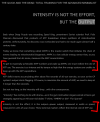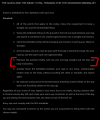Adachi
Level 7 Valued Member
BACKGROUND:
So, I'm just as unimpressed with a 2xBW bench press, where the bar travels some fraction of an inch in space, as anyone. And, I've been thinking of how I've been able to increase my rep speed and tempo via stance; while also doing my best to avoid a pause at the top of the rep in my Snatch Practice.
So, I will be experimenting a bit with form in my snatch per this thread. And, thank you all for the feedback.
That said, I found increased performance (as measured by the speed of each rep and the shortening of each set) via a stance that resembles a sumo deadlift.
And I found increased speed altitude and less arm and shoulder involvement.
And maybe I should be glad if a more conventional-deadlift-like-stance makes the reps or sets more difficult, or slower.
And maybe it's a feature, not a bug.
FORM:
As to the jump test for stance, I understand that this is a commonly used way of determining your stance.
I have some hesitation about it for myself.
I have a below-average jump height (this is a lifelong-noticed deficit compared to my peers).
I'm a big heavy guy 5'10 ~250lbs (with relatively shorter (stubbier) 28-inch inseam legs, and a relatively long torso wearing long cut jackets), and I've been told by a person in track and field sports that I'm basically "doing everything wrong", as far as jumping is concerned. He tried to work with me for a bit about getting closer to a basketball rim, but to no avail.
So, I'll just say - that from my perspective - I don't feel as though I have a lot to gain from jumping.
At any given point in time, I'm maxed out at my low capacity to jump vertically.
So, I look towards practicing rooting as a route toward increased strength and power expression.
So, with respect to form - I guess I am wondering, about the following excerpt with respect to my claimed increased output with the wider stance.
Am I cheating?
Am I just cheating myself?

POWER VS SPEED
so, Pavel explains that there is a distinction to be drawn between power and speed loads.
It would seem that my 24kg bell is arguably progressing from a power load to a speed load in my practice.
That said my understanding is that as power expression increases one is accelerating as much as possible, thereby generating higher and higher speeds. I suppose that I'm thinking that the difference between a power and speed load for the snatch is whether that change in speed occurs throughout the upswing or not. Or by what fraction it's occurring.
So, maybe a new snatching program might be of use in the near future. Probably KSK.
SPEED & TEMPO
Also, I've been pondering over the pause of a snatch at the top. I've been minimizing my pause at the top for a reason that I synthesized.
If it's true that in gauging the appropriateness of the bell size that one should pause at the top for less than 1 second, wouldn't 0 seconds be the best amount of pause?
If it's true that one is attempting to redline the CP system in order to elicit the MK reaction, then wouldn't one aim to minimize the fraction of rest between reps toward 0?
CAVEAT:
I happened upon the snatch standards in the book. which basically says: to pause at the top of the rep.
Also, I'm overdue for re-testing. ( was 4 months ago - 10 reps in 20 seconds. )

P.S.: As an aside - I am becoming a huge fan of steady-state-training. this long-term loading has proven to be effective for me. 10x10 delivers.
So, I'm just as unimpressed with a 2xBW bench press, where the bar travels some fraction of an inch in space, as anyone. And, I've been thinking of how I've been able to increase my rep speed and tempo via stance; while also doing my best to avoid a pause at the top of the rep in my Snatch Practice.
So, I will be experimenting a bit with form in my snatch per this thread. And, thank you all for the feedback.
Kettlebell - 24kg Kettlebell Snatch - Video for critique
Please take this opportunity to shame encourage me to be better. Today's snatch session - First time filming since I moved (January this year).
www.strongfirst.com
That said, I found increased performance (as measured by the speed of each rep and the shortening of each set) via a stance that resembles a sumo deadlift.
And I found increased speed altitude and less arm and shoulder involvement.
Kettlebell - Sumo is cheating
Well, color me conflicted. Today I had another 5 series Q&D day on the docket, and I discovered last week that moving to a wider stance in the snatch did 2 things for me, it helps avoid the bell touching my inner thigh, and also - apparently helps the bell feel like it's flying higher and...
www.strongfirst.com
And maybe I should be glad if a more conventional-deadlift-like-stance makes the reps or sets more difficult, or slower.
(Geoff's Reduced Leverage Training comes to mind.)
And maybe it doesn't matter if it's slower.And maybe it's a feature, not a bug.
(I'm not competitive, I'm training.)
FORM:
As to the jump test for stance, I understand that this is a commonly used way of determining your stance.
I have some hesitation about it for myself.
I have a below-average jump height (this is a lifelong-noticed deficit compared to my peers).
I'm a big heavy guy 5'10 ~250lbs (with relatively shorter (stubbier) 28-inch inseam legs, and a relatively long torso wearing long cut jackets), and I've been told by a person in track and field sports that I'm basically "doing everything wrong", as far as jumping is concerned. He tried to work with me for a bit about getting closer to a basketball rim, but to no avail.
So, I'll just say - that from my perspective - I don't feel as though I have a lot to gain from jumping.
At any given point in time, I'm maxed out at my low capacity to jump vertically.
So, I look towards practicing rooting as a route toward increased strength and power expression.
So, with respect to form - I guess I am wondering, about the following excerpt with respect to my claimed increased output with the wider stance.
Am I cheating?
Am I just cheating myself?

POWER VS SPEED
so, Pavel explains that there is a distinction to be drawn between power and speed loads.
It would seem that my 24kg bell is arguably progressing from a power load to a speed load in my practice.
That said my understanding is that as power expression increases one is accelerating as much as possible, thereby generating higher and higher speeds. I suppose that I'm thinking that the difference between a power and speed load for the snatch is whether that change in speed occurs throughout the upswing or not. Or by what fraction it's occurring.
So, maybe a new snatching program might be of use in the near future. Probably KSK.
SPEED & TEMPO
Also, I've been pondering over the pause of a snatch at the top. I've been minimizing my pause at the top for a reason that I synthesized.
If it's true that in gauging the appropriateness of the bell size that one should pause at the top for less than 1 second, wouldn't 0 seconds be the best amount of pause?
If it's true that one is attempting to redline the CP system in order to elicit the MK reaction, then wouldn't one aim to minimize the fraction of rest between reps toward 0?
CAVEAT:
I happened upon the snatch standards in the book. which basically says: to pause at the top of the rep.
Also, I'm overdue for re-testing. ( was 4 months ago - 10 reps in 20 seconds. )

P.S.: As an aside - I am becoming a huge fan of steady-state-training. this long-term loading has proven to be effective for me. 10x10 delivers.
Last edited:
